Professional reloader, Bob Shell, reviews the Shell Shock Technologies NAS3 Shell Cases and puts their claims of reduced cost and increased durability to the test.
Editors Note: Caution, Reloading is dangerous, read our “Reloading Disclaimer“. The reloading data published by this website is intended for discussion purposes only. As with all data collection, mistakes are possible. You have been warned.**
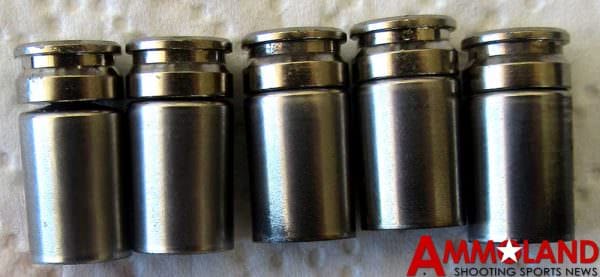
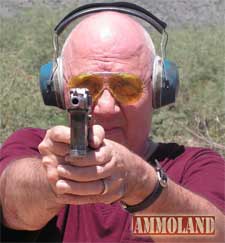
U.S.A. –-(Ammoland.com)- We are in an age where all types of novel ammo and reloading components are coming to the market. That is good news for us shooters as much of this is improvements over previous offerings.
One new company is Shell Shock Technologies which is making some innovative 9 mm ammo cases. These cases are definitely a new idea that is based on manufacturing methods not previously used to my knowledge.
Shell Shock Technologies came up with a novel idea, a 2-piece case that is made from a nickel alloy. The exact process is proprietary therefore the exact production methods used are not revealed.
Shell Shock Technologies NAS3 Shell Cases
I received some cases for evaluation and shooting along with the dies necessary to load those. There is a sizing and decapping die and a belling die. The bullet seating is done with a normal die which isn’t included. For detailed info, you can go here: https://shellshocktechnologies.com/ .
Since the technology is new they have a video on how to use their dies and cases. There are some differences from the typical methods, so it would behoove you to check out the video prior to using these cases. You can see the video here ( https://s3reload.com/technology/ ) and get other info pertinent to this product. The Shell Shock Technologies sizing and belling dies can be used for standard brass ammo cases, which is a plus because these new cases are superior to brass but will never replace them.
The Shell Shock Technologies NAS3 Shell Cases are a two-piece and are lighter than traditional brass. The bottom is an aluminum alloy while a nickel alloy part is the top, which makes the case magnetic. That makes them easier to pick up at a range. I weighed a number of them and they all weighed 35 grains with no variation. That would be a contributing factor in producing consistent ammo. Some brass cases I weighed came in at 63 to 64 grains so the advantage of lightweight cases would be evident if you had to carry a large amount of ammo. I measured several for length and they all came in at .7505 with no variation. That would be another feature that would contribute to accuracy and consistency.
If Shell Shock Technologies wanted to do some serious weight reduction by using a 50-grain bullet which is available or they could design their own. Such ammo would reduce both weight and recoil.
During my testing of the Shell Shock Technologies NAS3 Shell Cases I also received 200 rounds of factory loaded 9 mm with a copper 124 gr HP. They are produced by L-Tech Enterprises using Shell Shock Technologies cases. They sent some info showing penetration and weight retention results. They are consistent and if you are not a reloader this ammo is an option if you are not interested in reloading the Shell Shock Technologies NAS3 Shell Cases.
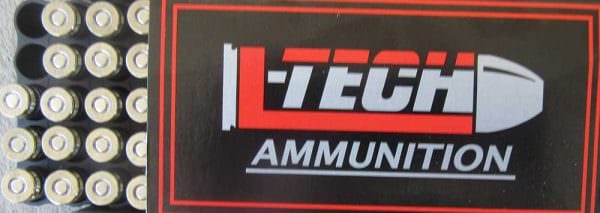
Loading the Shell Shock Technologies NAS3 Shell Cases
The first load I used is standard load using 5 grains of Winchester 231 Smokeless Powder and a 115-grain FMJ. The load is very mild and the cases were covered with soot which is normal with light loads. The reason is low-pressure loads do not seal the chamber which allows some powder to come back into the action. While messy it is seldom an issue in regards to performance. The soot cleans off easily for those who like good looking cases. Most nickel cases have that advantage though brass needs extra cleaning if that is important.
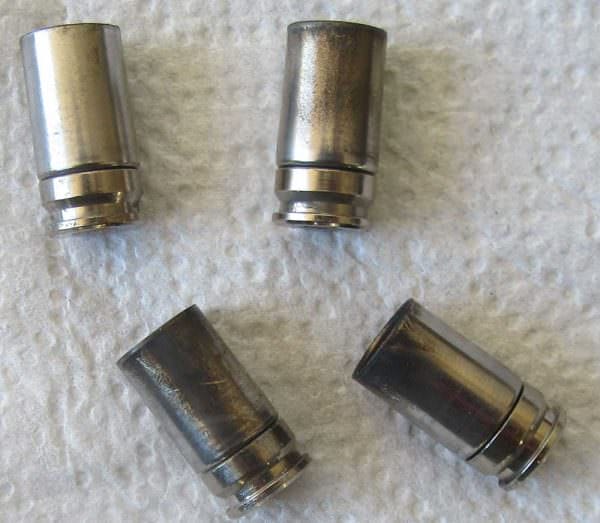
I have switched to standard sizing dies and have not had any issues. Some of the NAS3 Shell Cases have now been fired 3 or 4 times and they are holding up. I have 1 case that split in the normal way that was fired 3 times and it is my only failure. You do have to lube the cases to avoid excess labor in sizing. So, the issue of durability seems to be resolved.
The question is: why would you purchase the Shell Shock Technologies NAS3 Shell Cases as opposed to more conventional pieces?
Most 9 mm ammo cases last several firings and are easy to get. Performance wise there isn’t any real difference. My reason to purchase would be their light weight. If you wanted to carry a large amount of ammo the light weight case would be desirable. Now if you put this case with a light weight bullet then it would be a really desirable product. Liberty makes a 50 grain non-lead HP and that paired up with Shells Sock case should make some top rate ammo. Carrying a small amount of this ammo wouldn’t make a difference but carrying or transporting a large amount would show a sizable weight advantage. I have a 60-grain bullet to work with and at high velocity should make a nice self-defense load.
I sized some fired cases with normal 9mm sizing dies and don’t see any problems and effort is the same as the special dies. Belling is normal and priming feels a little odd. I tried some once fired cases using both sets of dies and the effort appears identical though lubing or case wax makes them easier to size. I noticed that a couple had increased the size of the groove. Not sure if that is a function of the dies or a case.
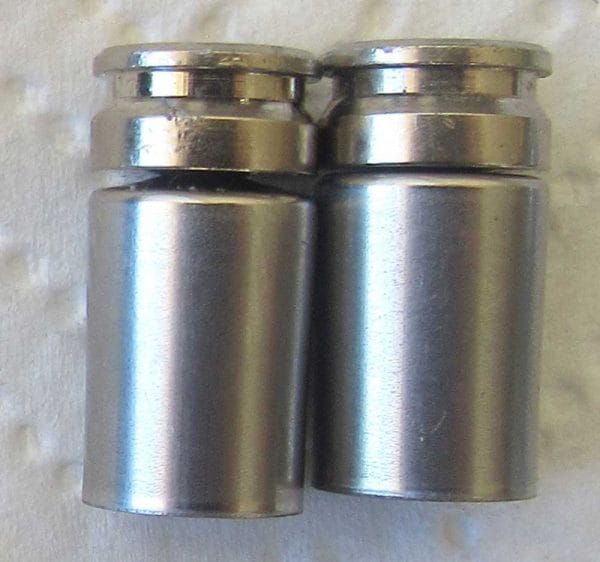
If you closely look at the NAS3 Shell Case groove it shows that the case is a two-piece case. I am also unsure of how the case is assembled either by a screw on or pressed together. The inside is slightly shallower than a conventional case but not by much, at an average of .05”.
A look at the inside of the Shell Shock Technologies custom die shows that it appears to be the same as a conventional die and like a good die has a tungsten core. With the photos, it appears that the construction is very different than a conventional piece of brass. Most of them felt like a two-stage deal though not very difficult to prime. It will be interesting to see how they go through a Dillon or RCBS progressive press.
I am going to load cases with the same load but using both sets of dies. I have some 60 gr HP and had to size the new cases to make them fit tight enough. The 115-gr cast did not need to have the new cases sized.
Another gun came into the mix a Sig with a 4” barrel. A Norinco was also used giving us different guns for testing and that gives us more info on what to expect with the cases and loads.

Some of the Shell Shock Technologies NAS3 Shell Cases have now been fired 7 times, there is no indication of any problems, and I am using RCBS dies only as I don’t see a need for the Shell Shock Technologies special ones. That would make these cases more desirable if it isn’t necessary to use special dies. I still recommend you get the Shell Shock Technologies NAS3 Shell Case dies to see which method works best for you. I just received some new powders from Chris Hodgdon resembling some older powders such as Red Dot. With one load, I used standard and Shell Shock Technologies’ cases to observe any differences. One load won’t tell the whole story but further testing will reveal the differences. In the end there was some differences between regular cases and Shell ShockTechnologies cases but not much.
In the end there was some differences between regular cases and Shell ShockTechnologies cases but not much.

Since I received some more gun powders from Hodgdon will try a couple with these cases and starting with the Red. The cases are holding up after 5 to 6 firings using the standard RCBS dies. The new Red powder needs some work, which has nothing to do with the cases. Many loads were tried along with three handguns to get a good overview of the Shell Shock case and some new powder and bullets were tried. Some of the lighter bullets were made by me as they are not generally available such as the 60-grain. The Acme Bullet Company has a cast 9mm bullet with a red coating which tends to make them slick and aids in feeding. In addition did include loads that didn’t do particularly well and for the sake of info they are included. Furthermore, they might shoot better in another handgun.
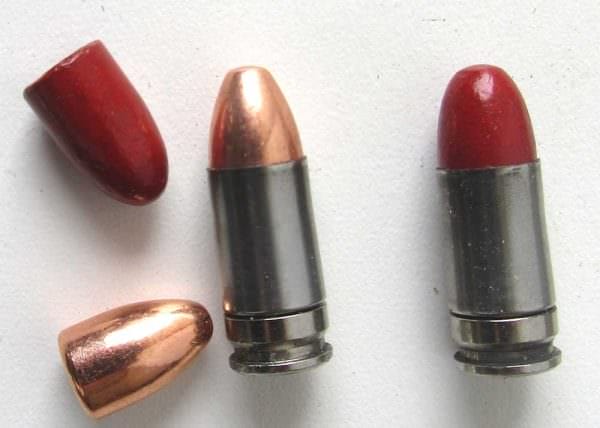
Shell Shock Technologies 9mm Cases Performance
| Load | Bullet | Velocity | Comment |
|---|---|---|---|
| 8 grs 231 | 60 gr HP new ogive | 1580.81 | Better |
| 8 grs WW 572 | 60 gr HP new ogive | 1458.79 | Very Consistent |
| 7 grs Tite Group | 60 gr HP | 1629.3 | Ok |
| 7 grs WW-572 | 115 gr FMJ Sig | 1153.46 | Nice Load |
| 7.5 grs WW-572 | 115 gr FMJ Sig | 1270.25 | Consistent Max |
| 7.5 grs 231 | 115 gr Cast Coated | 1139.82 | Very Consistent* |
| 6.5 grs WW 572 | 115 gr FMJ | 1063.18 | Consistent |
| 6.5 grs WW 572 | 115 gr FMJ Norinco | 1115.8 | Consistent |
| 6.5 grs WW 572 | 115 gr Cast Coated | 1099.14 | Super Consistent |
| 6.5 grs WW-572 | 130 gr FMJ | 1073.8 | Nice Load |
| 6.5 grs HS-6 | 135 gr HP Custom Die | 945.8 | Mild Ok* |
| 6.5 grs HS-6 | 135 gr HP RCBS Die | 912.1 | Fed Ok* |
| 6 grs 231 | 115 gr FMJ | 1107.5 | Consistent |
| 6 grs Red | 115 gr FMJ Norinco | 1283.83 | High ES |
| 6 grs Red | 115 gr FMJ | 1300.2 Berretta | High ES |
| 6 grs Unique | 135 gr HP RCBS Die | 1062.5 | Nice Load |
| 6 grs HS-6 | 147 gry Berry | 924 | Fed Better |
| 6 grs WW-572 | 147 gr Berry | 1080.89 Berreta | Nice |
| 5.5 grs Red | 130 gr Acme | 1084.64 Norinco | Fair |
| 5.5 grs Red | 130 gr Acme | 1090.5 Beretta | High ES |
| 5.2 grs Blue Dot | 158 gr Cast Coated | 762.18 | Consistent |
| 5 grs Red (Shell Shock) | 115 gr FMJ | 861.75 Beretta | Too Light |
| 5 grs Red (regular) | 115 gr FMJ | 827.46 Beretta | Too Light |
| 5 grs Red (Shell Shock) | 115 gr FMJ | 859.2 Norinco | Light |
| 5 grs Red (Regular) | 115 gr FMJ | 839.9 Norinco | Light |
| 4 grs Tite Group | 115 gr FMJ (Dillon) | 1094.7 | Consistent Feeds |
| L-Tech | 124 gr HP | 1085.55 | Consistent |
| L-Tech | 124 gr HP | 1044.5 | Consistent* |
I am using some CMA bullets but the ogives are too blunt and won’t feed so I have reformed them with a 9-mm bullet die that I bought years ago. They look better and the diameter has increased which has allowed them to be seated tighter and more consistent. Since the Shell Shock Technologies NAS3 Shell Cases weighs much less than conventional brass cases do a 60-grain bullet should really help. No point in having a light case and a standard weight bullet. There is a noticeable difference in weight which may allow someone to carry more ammo.
The 60 grain has some potential so I am going to work with it in regards to shape and loads. Since it is so light, velocity has to be high in order to cycle the gun. Such a load should be nice in a lightweight gun as it will cut down on recoil. When I changed the ogive, the diameter increased to .356-.357 which is probably the reason that they are more consistent than the unformed bullets which have a .355 diameter.

There are several companies that are using the Shell Shock Technologies NAS3 Shell Cases and I would like to see Liberty Ammunition pick them up with their 50-grain bullets.
Just for info, I weighed some 9-mm ammo with these results. They were rounded off and you can see that if a large quantity of ammo was carried the Shell Shock cases would cut down on the weight enough to make a difference. The CMA 60 gr did better but still jammed on occasion in the Norinco. Of course, that would render it unsuitable for defense work but I will try and work with the ogive but due to the short length that may be difficult.
The 147 grain did well with the heavier load of HS-6 with no stovepipes. Like any situation and gun, it is recommended that you thoroughly check out the ammo that is intended to be carry fodder. I took the 135 gr CMA and changed the ogive to a more rounded shape to ensure that it will feed in everything. In addition, they were .354 in diameter and the reshaping increased it to .358. Since there is a possibility that they may cause some problems reduced it to .356. Some .357 diameter bullets were swaged down to 356 a FMJ and a cast coated both round nose. The purpose is for sub sonic loads.
Liberty ammo makes some high-performance ammo using lighter than standard bullets. The 9 mm bullets weigh 50 grains so I measured a loaded round. The Shell Shock case weighs 35 grains so a loaded round with a Liberty bullet would weigh 85 grains.
I was curious as to case capacity of Shell Shock casings against other commercial cases. I used WW-572 filled to the top in each case and the results surprised me. I thought that the Shellshock case would have more capacity based on their weight. Here are the results though not scientific:
Shell Shock Cases Grain Capacity
| Shell Shock | 13.1 grains |
| Federal | 13.2 grains |
| PMC | 13.1 grains |
| GFI | 13.3 grains |
| Win | 13.2 grains |
As you can see they are very similar. The next step is to use the same load in both types of cases.
Shell Shock 9mm Cases
| Liberty Factory 9mm Case | 50 gr bullet | 120 |
| Shell Shock 9mm Case | 60 gr Bullet | 95 |
| Factory 9mm Case | 115 gr FMJ | 186 |
| Shell Shock 9mm | 115 gr FMJ | 150 |
| Shell Shock 9mm | 147 gr Barrry | 182 |
One thing that I haven’t noticed is any mention of the cases being reloaded on a progressive machine. That would be a plus if that is the case. Therefore, I had a friend run some through his Dillion RL550B press. Other than the requirement that they be lubed the process went off without a hitch. With a normal bullet, everything went fine. We fired some of the rounds made on the Dillon and they fed flawlessly so there should be no issues but they have to be lubed regardless of which dies or machine is used to load them. That new powder WW 572 seems to work well in the 9’S just need to adjust the loads.
Shell Shock Technologies NAS3 Shell Cases : Here to Stay
Based on my observations the Shell Shock Technologies NAS3 Shell Cases are here to stay. They are durable and can compete with conventional brass cases in regards to price and reloading life. For my purposes, they are perfect. I load small batches of test ammo for trying out various powders and bullets. I don’t use progressive loaders so anyone who does can figure out the best way to make large quantities of ammo. In a few years, they will have a good share of the market though they won’t entirely replace the brass cases for several reasons.
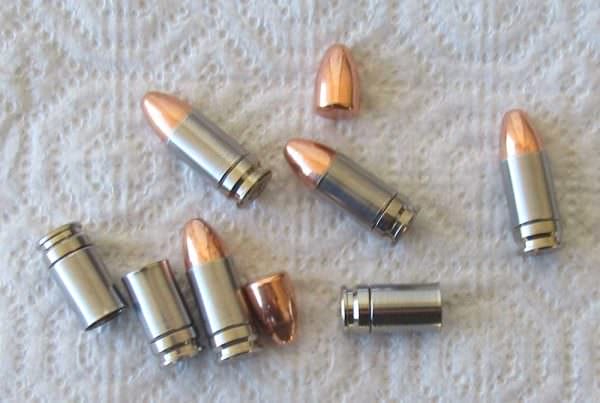
They have a few upsides such as durability and price. Since they are partly nickel alloy a magnet will pick them up. I have fired hundreds of rounds and had one case that split. I can live with that. The only downside is the requirement that they have to be lubed. A quick spray on may speed up the process especially with a progressive machine. I have talked to the company rep and he says that other calibers are in the works such as the 45 ACP and 223 among others. Hopefully, they will be available soon so I can see how they shoot.
I would recommend that you give the Shell Shock Technologies NAS3 Shell Case product a try and you will be a customer.
About Bob Shell:
A Custom Reloader of Obsolete and Antique Ammo, Bob Shell, writes about the subject of Guns, Ammo, Shooting and Related Subjects. Visit: www.bobshellsblog.blogspot.com.
